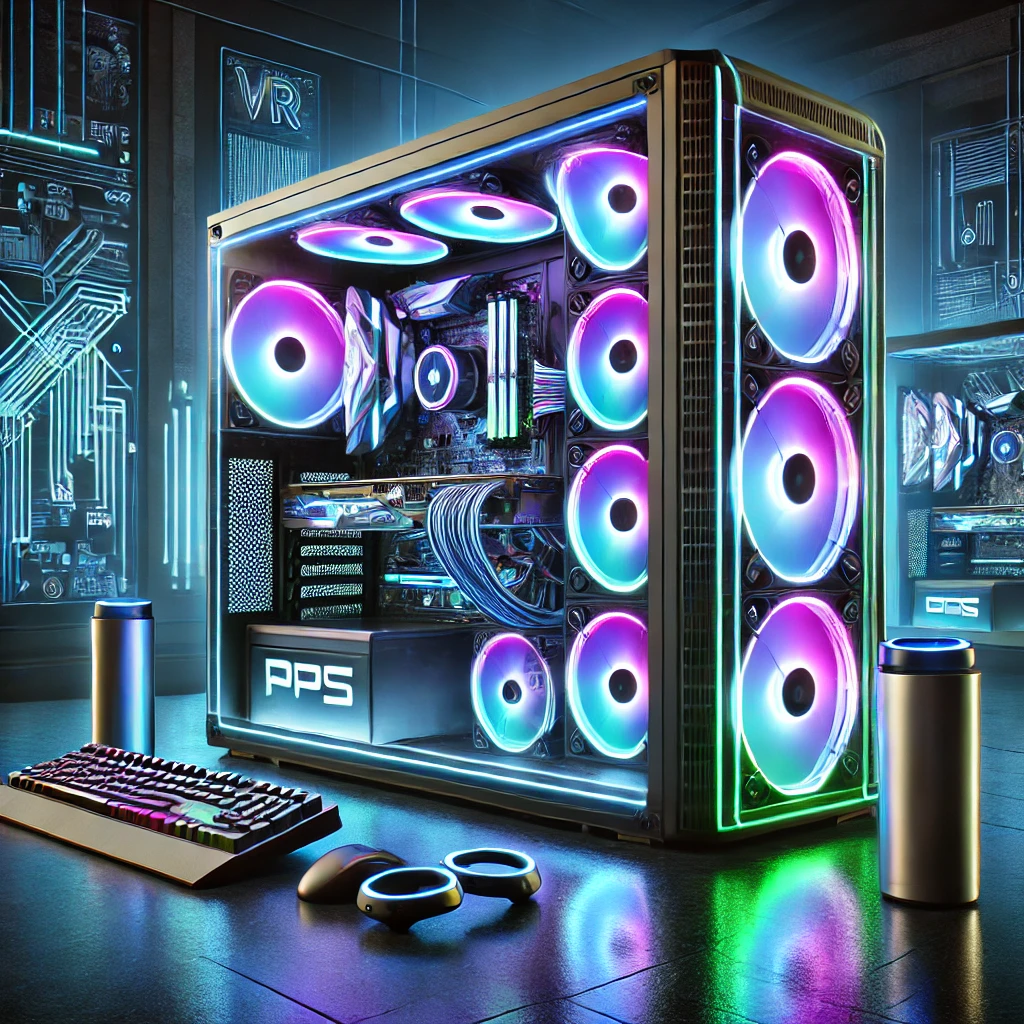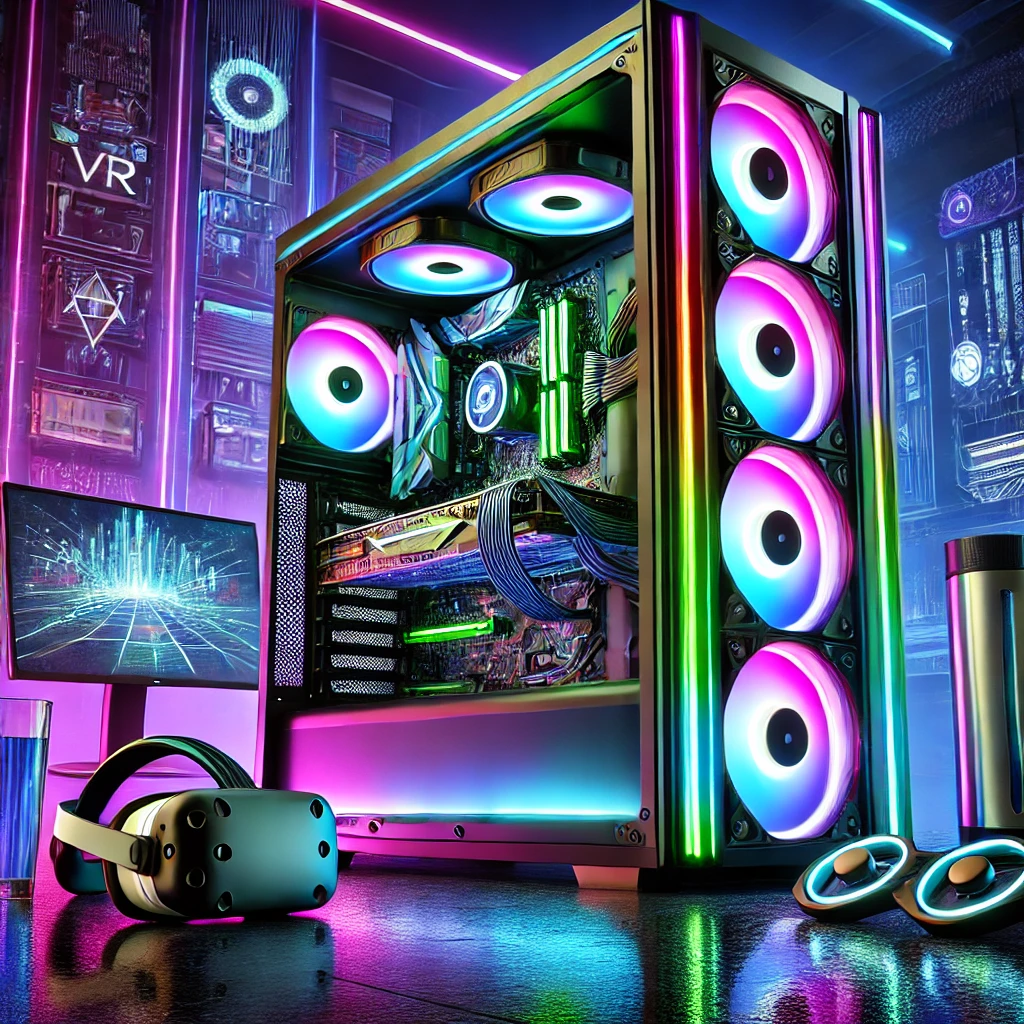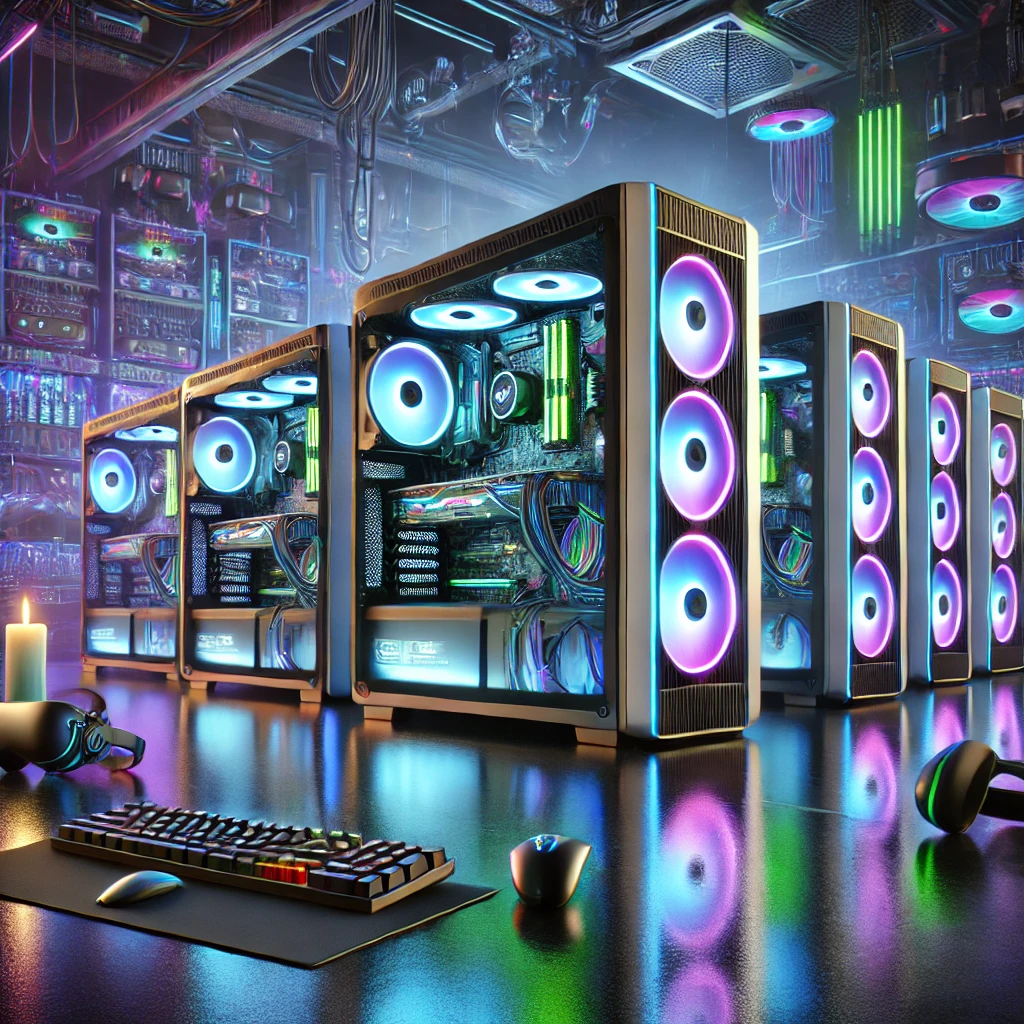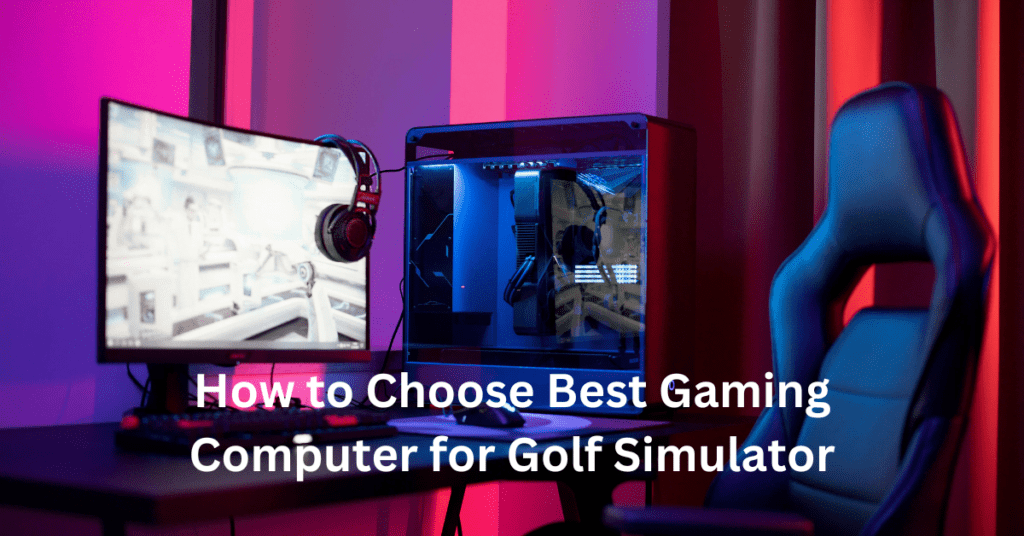Virtual reality (VR) technology has revolutionized the gaming industry by offering an immersive experience that transports players into vivid, interactive worlds. The evolution of VR began with simplistic simulations, but has rapidly advanced to complex environments powered by high-fidelity graphics and responsive motion tracking. This progression has not only expanded the possibilities for gameplay but has also heightened the requirements for the underlying hardware. Best Gaming PCs for VR
A powerful PC is crucial for an optimal VR experience. The demands of high-resolution visuals, seamless frame rates, and real-time interaction necessitate robust processing power, high-end graphics cards, and substantial memory. Gamers seeking to dive into VR must ensure their systems can handle these intensive tasks to avoid latency and motion sickness, which can detract from the immersive experience.
In this article, we will explore the essential components of a gaming PC that can meet the demands of modern VR technology. We’ll discuss how to choose the right hardware, from CPUs and GPUs to memory and storage options, and offer tips for assembling a system that maximizes VR performance. Whether you’re building a new PC or upgrading an existing one, this guide will help you create a setup that brings virtual worlds to life with stunning clarity and responsiveness.

Why Choosing the Right Gaming PC for VR Matters
Virtual reality (VR) offers an immersive experience that transports users into entirely new worlds. However, to seamlessly enter these digital realms, the performance of the gaming PC is paramount. VR environments are demanding; they require high frame rates, superior resolution, and minimal latency to function optimally. Typically, VR systems need to maintain a frame rate of at least 90 frames per second per eye to avoid lag that can break immersion and cause discomfort or even motion sickness.
When a PC underperforms in a VR setting, the consequences extend beyond mere disappointment. Poor graphics and delays due to inadequate processing power can lead to nausea and headaches, as the brain receives conflicting signals from what the eyes see and how the body responds. This sensory mismatch is often exacerbated by low frame rates and subpar graphics, common issues with PCs not optimized for VR.
Investing in a VR-ready gaming PC resolves these issues. Such systems are equipped with powerful GPUs, high-speed CPUs, and ample RAM to handle the intense computational demands of VR software. These components ensure that the visuals are not only stunning but also smooth, reducing the likelihood of VR-induced motion sickness. Additionally, VR-ready PCs often come with advanced cooling systems to prevent overheating, even during extended use.
The benefits of choosing a high-performance VR-ready PC extend beyond technical specifications. These systems are designed to provide the best possible experience in the VR world, allowing for deeper immersion, greater interactivity, and a more enjoyable gaming experience. By meeting and exceeding the required VR performance metrics, gamers can fully engage with VR content as intended, making the investment in a robust gaming PC a critical decision for enthusiasts looking to explore virtual landscapes without compromise.
Key Factors to Consider When Choosing a VR Gaming PC
When selecting a gaming PC for VR, several critical components need careful consideration to ensure an immersive and fluid VR experience.
Graphics Card (GPU): The GPU is crucial as it directly affects your VR experience. For 2025, the NVIDIA RTX 40 series and AMD Radeon RX 7000 series are highly recommended due to their ability to handle intensive VR graphics. The power of the GPU determines the fidelity and fluidity of the virtual environment, making it essential for avoiding latency and maintaining immersion.
Processor (CPU): VR gaming requires powerful processing capabilities. The Intel i9-13900K and AMD Ryzen 9 7950X stand out in 2025, offering robust multi-core performance critical for VR. These CPUs excel in handling simultaneous tasks and complex calculations, ensuring a seamless VR experience.
RAM: At least 16 GB of RAM is advisable for basic VR gaming, but 32 GB is preferred for an optimal experience. RAM speed also plays a significant role, impacting how quickly data moves between the processor and the memory, thus affecting game load times and performance.
Storage: An SSD is essential for VR gaming due to its faster read and write speeds compared to HDDs, significantly improving load times. A minimum of 1TB of storage is recommended to accommodate modern VR games, which are often large in size.
Cooling Systems: Effective cooling is vital, as VR gaming can strain the PC, generating considerable heat. Maintaining an optimal temperature through air or liquid cooling systems prevents performance throttling and prolongs the lifespan of the components.
Power Supply Unit (PSU): A reliable and sufficiently powerful PSU is crucial. For high-performance VR setups, a PSU with at least 750 watts is recommended, ensuring stable and safe power delivery to all components.
Connectivity and Ports: Adequate ports are necessary for connecting VR headsets and peripherals. Ensure your system has multiple USB-C, DisplayPort, and HDMI ports. Additionally, consider Bluetooth and Wi-Fi capabilities for a tidy and flexible wireless VR setup.
Top Pre-Built Gaming PCs for VR in 2025
1. High-End Option: Titan Vortex VR
The Titan Vortex VR is engineered with a powerful Intel Core i9 processor, an NVIDIA RTX 4090 graphics card, and 32GB of DDR5 RAM. It also boasts a 2TB NVMe SSD for lightning-fast load times and a 4K ready display output. With its advanced liquid cooling system, this PC handles prolonged VR sessions effortlessly.
Best for: Hardcore VR enthusiasts who demand the best performance and highest graphical fidelity.
Price range: $3,500 – $4,000
2. Mid-Range Option: Nova Rift GX2
Ideal for those who seek a balance between cost and performance, the Nova Rift GX2 features an AMD Ryzen 7 processor, an NVIDIA RTX 3070 Ti, 16GB of DDR4 RAM, and a 1TB SSD. This setup provides excellent VR capabilities without breaking the bank, supporting most VR games at high settings.
Best for: Experienced gamers looking for excellent value without compromising on a high-quality VR experience.
Price range: $1,800 – $2,200
3. Budget Option: CyberQuest VR Lite
The CyberQuest VR Lite is an entry-level VR gaming PC that includes an AMD Ryzen 5 processor, an AMD Radeon RX 6600 XT, 8GB of RAM, and a 512GB SSD. While it may not match the performance of higher-end models, it is perfectly suitable for most popular VR games at moderate settings.
Best for: Gamers entering the VR space on a budget who still want a satisfying VR gaming experience.
Price range: $800 – $1,000
Each of these pre-built PCs offers a different entry point into VR gaming, catering to various needs and budgets, ensuring that there’s a suitable option for every type of gamer in 2025.
Custom vs. Pre-Built: Which Is Better for VR?
When venturing into the world of virtual reality gaming, one of the critical decisions you’ll face is whether to build a custom PC or opt for a pre-built system. Each option has its distinct advantages and drawbacks, particularly when it comes to VR, which requires high performance to run smoothly and immersively.
Pros and Cons of Building Your Own VR Gaming PC
Pros:
1. Customization: Building your own PC allows you to select each component based on your specific needs and future-proofing preferences. This means you can prioritize a powerful GPU and CPU, essential for VR gaming.
2. Cost-Effectiveness: Often, assembling a PC yourself can be more cost-effective, especially if you already have some components like SSDs or power supplies.
3. Upgradability: A custom-built PC is typically easier to upgrade. You can replace parts as needed without being constrained by a pre-built system’s architecture.
Cons:
1. Complexity: Building a PC requires technical knowledge and patience, especially when troubleshooting issues that aren’t uncommon in new builds.
2. Time-Consuming: The research, assembly, and testing phases can be quite time-consuming, which might be a deterrent for those eager to jump straight into VR.
3. Warranty and Support: Unlike pre-built PCs, custom builds don’t come with a single warranty. Each part has its own warranty, and you’re responsible for dealing with multiple vendors in case of failures.
Benefits of Choosing a Pre-Built PC
Pros:
1. Convenience: Pre-built PCs are ready to use right out of the box, which means minimal setup time and quicker access to starting your VR experience.
2. Warranty and Support: These systems come with the assurance of support and a comprehensive warranty from a single vendor, making it easier to manage if something goes wrong.
3. Optimized System: Manufacturers often ensure that components are compatible and optimized for the best performance, which is crucial for VR.
Cons:
1.Cost: pre-built PCs can be more expensive than building a similar system yourself due to the added costs of assembly and brand premium
2. Limited Customization: You’re often limited to the configurations offered by manufacturers, which might not meet everyone’s needs or preferences for future upgrades.
Best Pre-Built Options for Different Budgets
For those leaning towards purchasing a pre-built system, the market offers a range of options that cater to various budgets:
Entry-Level: For those new to VR and looking for an affordable entry point, systems like the [XYZ Brand Model A] provide the necessary specs to get started without breaking the bank.
Mid-Range: A mid-range option like the [XYZ Brand Model B] strikes a balance between cost and performance, offering more powerful processors and GPUs suitable for most VR games.
High-End: For the ultimate VR experience, high-end systems such as the [XYZ Brand Model C] feature top-tier components, including the latest GPUs and CPUs, ample RAM, and SSDs for fast loading times and smooth performance.
In conclusion, the choice between building a custom PC or opting for a pre-built one depends largely on personal preference, technical comfort level, and budget. Each has its merits and can provide a satisfying VR gaming experience if chosen wisely.

Top Brands to Consider
When selecting a pre-built gaming PC for VR, the brand can play a significant role in determining your experience, not only through hardware quality but also in terms of customer support and warranty. Here are some of the most trusted brands in the VR gaming industry: Alienware, MSI, and ASUS ROG.
Alienware is renowned for its high-performance gaming systems, which are specifically designed to handle the demands of VR. Alienware PCs are known for their bold, futuristic designs and powerful components. A key benefit of opting for Alienware is their comprehensive warranty and exceptional customer support, which makes them a safe bet for those investing in a high-end gaming setup.
MSI has made a name for itself with its wide range of gaming laptops and desktops. MSI systems are often favored for their excellent graphics and cooling technologies, which are crucial for maintaining performance in VR applications. MSI also offers great customer service and reliable warranties, ensuring that gamers can rely on their systems for intense gaming sessions.
ASUS ROG (Republic of Gamers) is another leading brand that promises cutting-edge technology tailored for gamers. ASUS ROG machines are equipped with the latest in gaming tech, including high-refresh-rate displays and robust build quality. ASUS ROG stands out with its aesthetic appeal and durable components, alongside offering extensive warranty terms and easily accessible customer service.
Each brand brings something unique to the table, from Alienware’s premium support to MSI’s innovative cooling solutions and ASUS ROG’s dedication to the latest technology. When choosing a VR-ready gaming PC, consider what each brand excels in and how their strengths align with your gaming preferences and requirements. Also, take into account warranty durations and the efficiency of customer service, as these factors are crucial for long-term satisfaction and support.
VR Headset Compatibility
In 2025, virtual reality continues to evolve with newer, more advanced headsets hitting the market, such as the Oculus Quest 3, Valve Index 2, and PlayStation VR2. Each headset offers unique features and requirements, making the compatibility with your gaming PC a crucial aspect to consider for the best VR experience.
Popular VR Headsets in 2025
Oculus Quest 3: Known for its standalone capability, the Oculus Quest 3 also offers PC connectivity for more intensive VR games that require higher processing power. It is ideal for users seeking versatility and portability.
Valve Index 2: The successor to the popular Valve Index, this headset is celebrated for its high-fidelity visuals and precise tracking. It demands a robust GPU and CPU to handle its high-resolution display and fast refresh rates.
PS VR2: Specifically designed for use with PlayStation consoles, the PS VR2 can also be connected to PCs with proper adapters and software, targeting gamers who appreciate its unique game offerings and ergonomic design.
Best Gaming PCs Compatible with Each Headset
Choosing the right gaming PC to pair with these headsets involves considering the hardware requirements:
For Oculus Quest 3: A PC with a mid-range GPU, like the NVIDIA GTX 3060, and a decent CPU can handle the Oculus Link, providing a good balance of cost and performance.
For Valve Index 2: High-end PCs featuring GPUs such as the NVIDIA RTX 3080 or higher are recommended to leverage the headset’s full capabilities, especially in rendering detailed VR environments.
For PS VR2: While traditionally used with PlayStation, ensuring a PC has at least an AMD Ryzen 5 processor and a compatible video output for adapters is essential for cross-compatibility.
Tips for Ensuring Seamless Integration Between PC and Headset
1. Update Drivers: Always keep your GPU and USB drivers up to date to ensure compatibility and optimal performance with VR headsets.
2. Optimize Settings: Adjust your PC’s settings to match the specifications recommended by the headset manufacturer to avoid lags or crashes.
3. Check Ports: Ensure your PC has the required ports, like USB 3.0 or USB-C, needed for connecting the VR headset and consider using quality cables to maintain a stable connection.
Proper setup and compatible hardware go a long way in enhancing your VR gaming sessions, making it imperative to select a gaming PC that matches well with your chosen VR headset.
Performance Benchmarks
When selecting the best gaming PC for VR, performance is a key factor. This section provides a comparative analysis of different VR gaming PCs through FPS (frames per second) and resolution benchmarks for popular VR games like Half-Life: Alyx, Beat Saber, and VRChat.
Comparative Analysis of Different VR Gaming PCs
The performance of a VR gaming PC is often determined by its ability to maintain high FPS at optimal resolutions, ensuring a smooth and immersive experience. For example, a mid-range VR gaming PC might average 90 FPS on Half-Life: Alyx at high settings, while a high-end system could push beyond 120 FPS, providing a noticeably smoother visual experience.
FPS and Resolution Benchmarks
Half-Life: Alyx: Considered a benchmark for VR performance, high-end PCs using GPUs like the NVIDIA RTX 3080 can achieve up to 144 FPS at 1440p resolution, ensuring fluid motion and detailed environments. In contrast, entry-level VR systems may need to adjust settings downward to maintain a steady 60 FPS.
Beat Saber: Being less demanding, this game allows even lower-end PCs to perform well, typically running at 120 FPS on modest hardware. This ensures that fast-paced actions are rendered smoothly, critical for rhythm games.
VRChat: Known for its variable performance based on user-generated content, VRChat can run at 90 FPS on mid-range machines at high settings, though complex scenes may require more powerful hardware to maintain consistent frame rates.
Explanation of Benchmark Results
The benchmark results highlight the importance of selecting a VR system that not only meets the minimum requirements but excels, to future-proof one’s investment. High FPS and optimal resolution enhance not just visual clarity but also reduce motion sickness, which is crucial for prolonged VR sessions. These benchmarks are relevant as they directly impact the user experience, making the difference between an enjoyable VR session and a potentially uncomfortable one. Selecting the right VR gaming PC ultimately depends on one’s budget and the intended VR games to be played, with performance benchmarks serving as a crucial guide in this decision.
Future-Proofing Your VR Gaming PC
As VR technology advances, ensuring your gaming PC can handle future innovations is crucial for a lasting and immersive virtual reality experience. Here’s how to stay ahead of the curve in 2025 and beyond.
Emerging VR Technologies to Keep an Eye On
In 2025, VR technologies are pushing boundaries like never before. Eye-tracking and foveated rendering are becoming more common, reducing the graphical workload by adjusting the resolution based on where the user is looking. Haptic feedback technology is also advancing, promising to enhance the tactile responses in VR environments. As these technologies evolve, they will require robust processing power and advanced graphics capabilities.
Recommendations for Hardware Upgrades
To future-proof your VR gaming PC, consider the following hardware upgrades:
Graphics Card: Opt for the latest GPUs that support DirectX 12 Ultimate to handle future VR games with more complex graphics.
Processor: A CPU with multiple cores will improve your system’s ability to manage VR applications that are becoming increasingly CPU-intensive.
RAM: 16GB of RAM is the minimum, but 32GB or more is recommended for future VR applications and multitasking needs.
Storage: An NVMe SSD can drastically reduce load times and improve the overall responsiveness of your system.
Predictions for VR Game Development Trends and PC Performance Needs
Looking forward, VR game development is likely to emphasize more detailed virtual environments and realistic physics simulations, which will demand even more from gaming PCs. Social VR experiences are also on the rise, requiring systems to manage multiple data streams efficiently. To keep up, gamers will need PCs that not only meet the current specs but also have the capacity to integrate upcoming technologies seamlessly.
Investing in a high-performance PC with these upgrades will ensure that you can enjoy cutting-edge VR games as they evolve, making your gaming experience truly future-proof.
Maintenance Tips for Your VR Gaming PC
Maintaining a VR-ready gaming PC is crucial to ensure optimal performance and longevity. Here are essential maintenance tips to keep your system running smoothly, especially designed to cater to the high demands of VR gaming.
How to Keep Your PC Running Smoothly for VR Gaming
1. Regular Updates: Keep your operating system, drivers (especially GPU drivers), and VR software up to date. Updates can fix bugs, improve performance, and provide new features that enhance stability and compatibility.
2. Performance Monitoring: Utilize tools like MSI Afterburner or Windows Task Manager to monitor your system’s performance. Keeping an eye on the CPU and GPU temperatures can help you detect if your system is overheating, which is critical for preventing hardware damage.
Recommended Software and Settings for Performance Optimization
1. Optimization Software: Consider using system optimization tools such as CCleaner to remove unused files and clean up the registry. For VR, setting your PC’s power plan to ‘High Performance’ is recommended to ensure that your system utilizes its resources fully.
2. VR Settings: Adjust the VR software settings according to your system’s capabilities. Lowering the resolution or the visual effects can significantly improve performance without substantially detracting from the VR experience.
Cleaning and Maintaining Cooling Systems
1. Dust Cleaning: Dust accumulation can block airflow and lead to overheating. Open your PC case every few months to clean out dust with compressed air, focusing on the fans and heat sinks.
2. Thermal Paste Application: Reapply thermal paste on your CPU and GPU every couple of years. Fresh thermal paste improves the heat transfer from your processors to the heat sink, keeping your system cooler during intensive gaming sessions.
By following these tips, you can maintain your VR gaming PC in top condition, ensuring that each virtual reality experience is as immersive and uninterrupted as possible. Regular maintenance not only boosts performance but also extends the lifespan of your components.

Conclusion
In the quest to find the ideal VR gaming setup, gamers are faced with two main choices: building a custom PC or purchasing a pre-built one. Each approach has its advantages: custom PCs offer unparalleled customization and potentially lower costs, while pre-built systems provide convenience, reliability, and immediate playability.
For those who revel in the intricacies of tech and have specific performance requirements, building a custom PC might be the way to go. However, if you prioritize ease and quick setup, a pre-built system could be your best bet, especially with options available for every budget—from entry-level to high-end systems designed for the most immersive VR experiences.
Ultimately, the decision should align with your technical skills, budget, and how you want to experience VR. Take the time to assess your needs and research to ensure that your chosen PC meets the demands of the latest VR games and applications.
We encourage you to share your own VR setup experiences or any questions you might have in the comments section below. Whether you’re a seasoned builder or a first-time buyer, your insights can help others make informed decisions in the dynamic world of VR gaming.
FAQs for Best Gaming PCs for VR
1. What are the minimum specifications required for a VR gaming PC in 2025?
The minimum specifications for a VR gaming PC in 2025 typically include a high-performance GPU (such as the NVIDIA RTX 3060 or AMD Radeon RX 6600 XT), a multi-core CPU (Intel i5-12600K or AMD Ryzen 5 5600X), 16 GB of RAM, and an SSD with at least 500 GB of storage. Ensure your PC has the necessary ports (USB-C, DisplayPort) for VR headset compatibility.
2. Is a laptop good enough for VR gaming in 2025?
Yes, but it depends on the laptop. To run VR smoothly, a gaming laptop should have a high-end GPU (e.g., NVIDIA RTX 3080 or newer), a powerful CPU, and at least 16 GB of RAM. Laptops also need to have ports compatible with VR headsets and proper cooling systems to avoid performance throttling.
3. What are the best pre-built VR gaming PCs for beginners?
Some of the best pre-built VR gaming PCs for beginners in 2025 include models like the HP Omen 45L, ASUS ROG Strix G15, and Alienware Aurora R14. These PCs offer a balance of performance and affordability, making them ideal for new VR gamers.
4. Can I upgrade my current gaming PC to make it VR-ready?
Yes, you can upgrade your existing gaming PC to be VR-ready by focusing on key components. Upgrading to a compatible GPU, adding more RAM (preferably 16 GB or higher), ensuring you have a powerful CPU, and installing an SSD can help. Don’t forget to check your power supply capacity and cooling system to handle the added load.
5. What VR headsets are best paired with high-performance gaming PCs?
The top VR headsets in 2025 include the Oculus Quest 3, Valve Index 2, and the PS VR2 (for PC compatibility with additional software). These headsets offer high resolution, low latency, and excellent refresh rates for an immersive experience. Ensure your PC meets the recommended specifications of the chosen headset for optimal performance.




